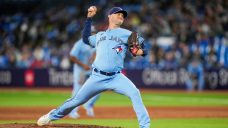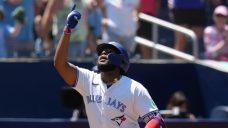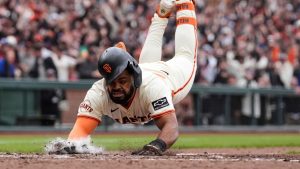When it comes to outside-the-box baseball strategies, the impetus for their creation is more likely to be pure desperation than a lightning bolt of inspiration.
The Tampa Bay Rays wouldn’t have gotten into the opener business if they’d had five traditional starters who were rolling. Teams around the majors wouldn’t have intentionally walked Barry Bonds at an unprecedented rate in the early 2000s if pitching to him wasn’t a nightmare the likes of which they’d never seen before. The Toronto Blue Jays wouldn’t have given Vladimir Guerrero Jr. his first start at third base in five years last Sunday if they could consistently score.
Returning Guerrero to his original position isn't ludicrous at a conceptual level, but the 25-year-old won a Gold Glove at first as recently as 2022 — and he struggled at the hot corner as a rookie. While Vladdy isn’t headed to third full-time, he’s now spent two of his last five games there and hasn’t done anything to jeopardize the idea yet.
He even made a nice play shifted towards short on Sunday.
The original premise of having Guerrero playing third from time to time was to get Justin Turner and Daniel Vogelbach into the lineup at the same time (and by extension phase out some at-bats for struggling infielders like Ernie Clement and Cavan Biggio). The veterans that Toronto is looking to lean on have wRC+ marks on the season of 97 and 78 respectively, so this whole idea may die on the vine in the relatively near future.
There’s no sense sacrificing defence for offence if the bat-first players you are giving additional run to don’t produce. There’s also a real possibility that the best use of the Blue Jays’ DH spot is a Vogelbach/Turner platoon as Guerrero plays first. The team probably wouldn’t be thrilled with the idea of turning a $13-million investment like the 39-year-old Turner into a part-time player, but he has a 722 OPS vs. righties and .909 mark against southpaws since the beginning of last year.
Add in the possibility of triple-A callups altering the position-player mix, and we may be in the middle of an abnormal moment in time that isn’t destined to continue.
While we’re here, we might as well figure out how the Blue Jays can make the Guerrero-at-third premise make sense, though.
In most cases, the first thing to look at in this case would be Toronto’s starting pitchers. Although Guerrero doesn’t project to mishandle the majority of the balls coming his way, it still wouldn’t make sense to have a somewhat rusty fielder with suboptimal lateral quickness play behind an elite groundball pitcher like Logan Webb or Framber Valdez.
Luckily, or unluckily, the Blue Jays don’t have anyone who fits that mould on staff. None of their four regular starters generate abnormally high groundball rates — or especially low ones.
When you look at the numbers below, keep in mind that the MLB average this season is 42.6 per cent:
That means that throwing Guerrero out at third will have more to do with Toronto’s opponent.
If the Blue Jays are playing a southpaw, it seems unlikely that they’ll put him at the hot corner because there'll be no need to force Vogelbach into the order. The 31-year-old has only taken 16.7 per cent of his career plate appearances against lefties and he’s hit a brutal .128/.246/.214 in those opportunities.
Playing both of the Blue Jays’ catchers and keeping Turner in there would open up a lane, but Alejandro Kirk’s rough start to the season has made the dual-catcher look less appealing. While there’s an argument for making sure Jansen is in the lineup even when he’s not catching, he has earned his full days off, and the Blue Jays might not have an appetite for pushing one of their most valuable hitters when he’s had durability issues in the past.
That makes the focus of this experiment right-handed starters that call out for the presence of Vogelbach — and his career 124 wRC+ vs righties — in the DH spot, leaving first base to Turner, or possibly Spencer Horwitz if he reaches the majors soon.
Considering the state of the Blue Jays offence, a player who tends to hit that well against right-handed pitching would seem to be a necessity, but Vogelbach is a particular type of hitter who is best used in specific matchups.
Specifically, he’s about as pure a fastball hitter as you’re going to find.
Here are his splits against fastballs (including cutters) and non-fastballs since the beginning of the 2022 season:
It’s not uncommon for hitters to perform better against hitters but that’s an extreme split and it’s been even more noticeable recently as Vogelbach doesn’t have a single hit on a non-fastball this season.
As a result, when the Blue Jays are targeting games to use a Vladdy-at-third alignment that gets Vogelbach and Turner into the lineup, they should be looking at righty starters who throw a lot of heaters — or at least more than the average starting pitcher (55.2 per cent).
To see how common that would be, we took a look at every regular starter in the AL East, according to the latest Roster Resource depth charts, and picked out the guys it might make sense to use Guerrero at third against.
Corbin Burnes - Yes. The Blue Jays literally used Vladdy at 3B against Burnes on Tuesday.
Albert Suárez - Yes. RHP who throws 78 per cent fastballs.
Cade Povich - No. LHP.
Kyle Bradish - No. Below-average fastball rate.
Cole Irvin - No. LHP.
Grayson Rodriguez - No. Over 50 per cent non-fastballs.
Carlos Rodón - No. LHP.
Marcus Stroman - Yes. Well above-average fastball rate
Cody Poteet - Yes/edge case with a fastball rate less than one per cent above average.
Nestor Cortes Jr. - No. LHP.
Luis Gil - Yes/edge case with a fastball rate less than two per cent above average.
Zach Eflin - Yes. Fastball rate north of 65 per cent.
Aaron Civale - Yes. Fastball rate above 60 per cent.
Taj Bradley - Yes Fastball rate north of 60 per cent.
Zack Littel - Yes. Fastball rate above 60 percent.
Ryan Pepiot - No. Below-average fastball rate.
Brayan Bello - No. Fastball rate at 40.3 per cent.
Kutter Crawford - Yes. Fastball rate over 60 per cent.
Nick Pivetta - Yes. Above-average fastball rate.
Tanner Houck - No. Fastball rate below 40 per cent.
Cooper Creswell - No. Fastball rate below 45 per cent.
That mini breakdown comes from a relatively small sample, but it’s 21 of the starters Toronto is most likely to see, and you could make a case for the Guerrero-to-third plan with 11 of them — with two that could go either way.
Horwitz’s arrival in place of Vogelbach would change things slightly, but he still wouldn’t be forcing his way into the lineup with southpaws, so the difference would be tweaking which right-handers it would make sense to use him against. If both were on the roster, Vogelbach would still be the biggest pivot man in the scenario because he must occupy the DH spot when he plays.
For now, the Blue Jays’ experiment with Guerrero is more of an interesting wrinkle than a profound shift — but because the team’s rotation isn’t packed with groundballers, they aren’t likely to be badly burned by playing around with it.
Guerrero’s big arm and experience at the position should be enough to keep his head above water at third when the team throws him out there. Based on what we’ve seen in 2024, the harder part of making the concept work might be getting the defensively-limited guys the Blue Jays put in the first base and DH spots to justify Guerrero's presence at the hot corner with their production.








COMMENTS
When submitting content, please abide by our submission guidelines, and avoid posting profanity, personal attacks or harassment. Should you violate our submissions guidelines, we reserve the right to remove your comments and block your account. Sportsnet reserves the right to close a story’s comment section at any time.